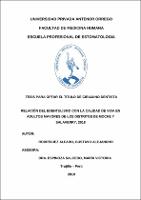Mostrar el registro sencillo del ítem
Relación del edentulismo con la calidad de vida en adultos mayores de los distritos de Moche y Salaverry, 2018.
| dc.contributor.advisor | Espinoza Salcedo, María Victoria | |
| dc.contributor.author | Rodríguez Alfaro, Gustavo Alejandro | |
| dc.creator | Rodríguez Alfaro, Gustavo Alejandro | |
| dc.date.accessioned | 2019-03-06T15:47:11Z | |
| dc.date.available | 2019-03-06T15:47:11Z | |
| dc.date.issued | 2019 | |
| dc.identifier.uri | https://hdl.handle.net/20.500.12759/4518 | |
| dc.description.abstract | Determinar la relación del edentulismo con la calidad de vida en adultos mayores de los distritos de Moche y Salaverry, 2018. Material y Método: El estudio fue de corte transversal, se evaluó a 92 adultos mayores. Se empleó Test de OHIP para determinar la calidad de vida y clasificación de Kennedy para determinar la pérdida dental. Resultados: Se encontró según Kennedy que el mayor porcentaje de edentulismo fue en maxilar inferior (16%) en Clase I-M1. Según calidad de vida se encontró en nivel moderado (72%). Según enfermedad sistémica, fue en maxilar inferior en Clase I-M1 en pacientes con hipertensión siendo moderado (12%) en calidad de vida. Según grado de instrucción, fue en maxilar superior en Clase II-M2 (7%) y maxilar inferior en Clase I-M1 (7%) con primaria completa, presentando impacto moderado en calidad de vida. Según edad, lo obtuvo el maxilar superior en Clase II-M2 (11%) en pacientes con 71-81 años, presentando impacto alto. Conclusión: Si existe relación entre edentulismo y calidad de vida. | es_PE |
| dc.description.abstract | To determine the relationship of edentulism with quality of life in older adults in the districts of Moche and Salaverry, 2018. Material and Method: The study was cross-sectional and 92 elderly adults were evaluated. The OHIP Test was used to determine the quality of life and the Kennedy classification to determine tooth loss. Results: According to Kennedy, it was found that the highest percentage of edentulism was in the lower jaw, which presented 16% in Class I-M1. According to the quality of life, it was found at a moderate level (72%). According to systemic disease, the highest percentage was in the lower maxilla in Class I-M1 in patients with hypertension, being moderate (12%) in their quality of life. According to educational level, the highest percentage was in the upper jaw in Class II-M2 (7%) and lower jaw in Class I-M1 (7%) with complete primary, presenting a moderate impact on their quality of life. According to age, the highest percentage was obtained in the upper maxilla in Class II-M2 (11%) in patients aged 71-81 years, presenting high impact Conclusion: If there is a relationship between edentulism and quality of life. | en_US |
| dc.description.uri | Tesis | es_PE |
| dc.format | application/pdf | es_PE |
| dc.language.iso | spa | es_PE |
| dc.publisher | Universidad Privada Antenor Orrego - UPAO | es_PE |
| dc.relation.ispartofseries | T_EST_571 | |
| dc.rights | info:eu-repo/semantics/openAccess | es_PE |
| dc.source | Universidad Privada Antenor Orrego | es_PE |
| dc.source | Repositorio institucional - UPAO | es_PE |
| dc.subject | Edentulismo | es_PE |
| dc.subject | Test de Liker | es_PE |
| dc.title | Relación del edentulismo con la calidad de vida en adultos mayores de los distritos de Moche y Salaverry, 2018. | es_PE |
| dc.type | info:eu-repo/semantics/bachelorThesis | es_PE |
| thesis.degree.level | Título Profesional | es_PE |
| thesis.degree.grantor | Universidad Privada Antenor Orrego. Facultad de Medicina Humana | es_PE |
| thesis.degree.name | Cirujano Dentista | es_PE |
| thesis.degree.discipline | Estomatología | es_PE |
Ficheros en el ítem
Este ítem aparece en la(s) siguiente(s) colección(es)
-
Estomatología [567]

